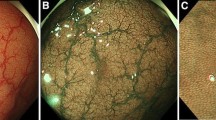Abstract
Background
Narrowband imaging (NBI) allows characterization of colorectal polyps during endoscopy; however, this is underutilized by most US physicians. The aim of this study was to assess diagnostic performance of an NBI scoring system, based on the NBI international colorectal endoscopic classification, and determine a threshold score yielding the highest negative predictive value (NPV) in the characterization of colorectal neoplasia.
Methods
During colonoscopy, colorectal lesions were scored using the NBI scoring system on a 0–3 scale for NBI findings. All lesions were biopsied or endoscopically removed for pathological examinations.
Results
Two hundred and three patients were enrolled, and a total of 156 colorectal lesions were detected in 67 patients. Diagnostic yields under white light mode showed limited diagnostic performance [accuracy 75.6 % (68.9–82.3), sensitivity 69.2 % (58.6–78.3), specificity 84.6 % (73.1–92.0), positive predictive value (PPV) 86.3 % (75.8–92.9), NPV 66.3 % (55.0–76.0)]. Of NBI threshold scores from 1 to 3 for the diagnosis of neoplastic lesion, the score of ≥1 resulted in an accuracy of 88.5 % (83.5–93.5), sensitivity of 97.8 % (91.5–96.6), and specificity of 75.4 % (62.9–84.9), with PPV of 84.8 % (76.1–90.8) and NPV of 96.1 % (85.4–99.3).
Conclusions
The threshold value of ≥1 in this simplified NBI scoring system yielded the highest sensitivity and NPV for non-adenomatous colorectal polyps. This scoring system is simple to apply and is superior to white light endoscopy.



Similar content being viewed by others
References
Kubo H, Fujiwara T, Jussila L et al (2000) Involvement of vascular endothelial growth factor receptor-3 in maintenance of integrity of endothelial cell lining during tumor angiogenesis. Blood 96:546–553
Konerding MA, Fait E, Dimitropoulou C et al (1998) Impact of fibroblast growth factor-2 on tumor microvascular architecture. A tridimensional morphometric study. Am J Pathol 152:1607–1616
Konerding MA, Fait E, Gaumann A (2001) 3D microvascular architecture of pre-cancerous lesions and invasive carcinomas of the colon. Br J Cancer 84:1354–1362
Sano Y, Ikematsu H, Fu KI et al (2009) Meshed capillary vessels by use of narrow-band imaging for differential diagnosis of small colorectal polyps. Gastrointest Endosc 69:278–283
Horimatsu T, Sano Y, Kaneko K et al (2009) Relationship between MVD and meshed-capillaries using magnifying NBI colonoscopy in colorectal precursor lesions. Hepatogastroenterology 56:372–377
Kessler WR, Imperiale TF, Klein RW, Wielage RC, Rex DK (2011) A quantitative assessment of the risks and cost savings of forgoing histologic examination of diminutive polyps. Endoscopy 43:683–691
http://www.gastro.org/advocacy-regulation/regulatory-issues/2013-physician-fee-schedule-b, Last Accessed 30 July 2014
Rex DK, Kahi C, O’Brien M et al (2011) The American Society for Gastrointestinal Endoscopy PIVI (preservation and incorporation of valuable endoscopic innovations) on real-time endoscopic assessment of the histology of diminutive colorectal polyps. Gastrointest Endosc 73:419–422
Hewett DG, Kaltenbach T, Sano Y et al (2012) Validation of a simple classification system for endoscopic diagnosis of small colorectal polyps using narrow-band imaging. Gastroenterology 143:599–607
Snover DC, Ahnen DJ, Burt RW, Odze RD (2010) Serrated polyps of the colon and rectum and serrated polyposis. In: Bosman FT, Carneiro F, Hruban RH et al (eds) WHO classification of tumours of the digestive system. IARC, Lyon, pp 160–165
Hirata M, Tanaka S, Oka S et al (2007) Evaluation of microvessels in colorectal tumors by narrow band imaging magnification. Gastrointest Endosc 66:945–952
Kanao H, Tanaka S, Oka S et al (2009) Narrow-band imaging magnification predicts the histology and invasion depth of colorectal tumors. Gastrointest Endosc 69:631–636
Jass JR (2001) Serrated route to colorectal cancer: back street or super highway? J Pathol 193:283–285
Jass JR, Whitehall VL, Young J, Leggett BA (2002) Emerging concepts in colorectal neoplasia. Gastroenterology 123:862–876
Iino H, Jass JR, Simms LA, Young J, Leggett B, Ajioka Y et al (1999) DNA microsatellite instability in hyperplastic polyps, serrated adenomas, and mixed polyps: a mild mutator pathway for colorectal cancer? J Clin Pathol 52:5–9
O’Brien MJ, Yang S, Mack C, Xu H, Huang CS, Mulcahy E et al (2006) Comparison of microsatellite instability, CpG island methylation phenotype, BRAF and KRAS status in serrated polyps and traditional adenomas indicates separate pathways to distinct colorectal carcinoma end points. Am J Surg Pathol 30:1491–1501
Spring KJ, Zhao ZZ, Karamatic R, Walsh MD, Whitehall VL, Pike T et al (2006) High prevalence of sessile serrated adenomas with BRAF mutations: a prospective study of patients undergoing colonoscopy. Gastroenterology 131:1400–1407
Jass JR, Baker K, Zlobec I, Higuchi T, Barker M, Buchanan D et al (2006) Advanced colorectal polyps with the molecular and morphological features of serrated polyps and adenomas: concept of a ‘fusion’ pathway to colorectal cancer. Histopathology 49:121–131
Higuchi T, Sugihara K, Jass JR (2005) Demographic and pathological characteristics of serrated polyps of colorectum. Histopathology 47:32–40
Torlakovic E, Skovlund E, Snover DC, Torlakovic G, Nesland JM (2003) Morphologic reappraisal of serrated colorectal polyps. Am J Surg Pathol 27:65–81
Rex DK, Ahnen DJ, Baron JA et al (2012) Serrated lesions of the colorectum: review and recommendations from an expert panel. Am J Gastroenterol 107:1315–1330
Kimura T, Yamamoto E, Yamano HO et al (2012) A novel pit pattern identifies the precursor of colorectal cancer derived from sessile serrated adenoma. Am J Gastroenterol 107:460–469
Nakao Y, Saito S, Ohya T, et al. (2013) Endoscopic features of colorectal serrated lesions using image-enhanced endoscopy with pathological analysis. Eur J Gastroenterol Hepatol 25:981–988
Author information
Authors and Affiliations
Corresponding author
Ethics declarations
Disclosures
Christopher C. Thompson: Consultant for Olympus. Hiroyuki Aihara, Nitin Kumar, Marvin Ryou, Robert Burakoff, Marwan Abou Gergi, and Michele B. Ryan have no conflicts of interest or financial ties to disclose.
Rights and permissions
About this article
Cite this article
Aihara, H., Kumar, N., Ryou, M. et al. Prospective evaluation of a simplified narrowband imaging scoring system for a differential diagnosis of colorectal lesions. Surg Endosc 30, 3598–3603 (2016). https://doi.org/10.1007/s00464-015-4660-5
Received:
Accepted:
Published:
Issue Date:
DOI: https://doi.org/10.1007/s00464-015-4660-5




